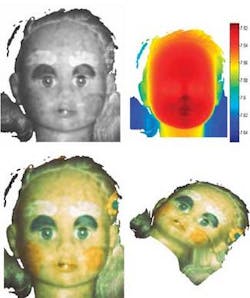MULTISPECTRAL IMAGING: Raman effect enables multispectral 3-D imaging
Stimulated-Raman-scattering (SRS) effects in optical fiber can be used to create multispectral visible and IR lasers with applications in molecular spectroscopy, communications, medical diagnostics, and environmental monitoring. By exploiting this SRS phenomenon in conjunction with laser radar, researchers at the Danish Defense Research Establishment (DDRE; Copenhagen, Denmark) have created what they believe to be the first multispectral 3-D imaging system.1 Although 3-D imaging systems using laser radar have been previously demonstrated, a single monochromatic laser is traditionally used and color information is lost.
To create the SRS multispectral source for the imaging system, a picosecond-pulsed green laser (532 nm Nd:YAG frequency diode-pumped solid-state dual-chip nanolaser with 8.6 kW peak power and 4.3 µJ pulse energy) was input to a 30-m-long single-mode silica fiber with 3.5 µm core diameter. By gradually increasing the power of the green pump laser above the threshold at which SRS occurs (approximately 1 mW), the researchers converted the pump laser wavelength within the fiber to a series of predictable Stokes wavelengths consisting of approximately five narrow peaks between 532 and about 610 nm with a continuous tail in the red and near-IR portion of the spectrum.
The imaging camera contained a 25-mm-diameter intensified microchannel plate and a 752 × 582-pixel CCD measuring 6 × 4.5 mm. A trigger line from the green laser was connected directly to the CCD camera so that the timing of the individual pulses could be known to picosecond accuracy for the purpose of distance ranging or laser radar. Depending on the imaging optics used (microscope or telescope), the range of the system can be adjusted for applications varying from biological-tissue analysis to facial recognition and other longer-range imaging tasks up to approximately 200 m.
For imaging, a gated viewing technique and time-of-flight measurements are used. With the camera gated to a fraction of a nanosecond such that only a brief range of reflected light is recorded through a green-colored filter (for which reflection was the highest), 50 to 500 2-D images are collected with increased delay time for each image. By summing over the 2-D frames and using parameters from the imaging system, the distance parameters for the image can be determined and a 3-D monochromatic image produced. In addition to the green image, two 2-D images taken using a red and yellow filter give information about the reflectivity of the object being imaged at three different wavelengths. This information is sufficient to reveal color information about the object so that it can be accurately reconstructed in full 3-D color (see figure).
Although more costly and cumbersome, three different colored lasers or a tunable laser could be used; however, in this method, the laser pulse widths and triggering are the same for the different wavelengths, making the system simple, fast, with submillimeter accuracy, and requiring no additional color corrections in the final image.
“One of the advantages of our system is speed: 50 frames with 50 Hz frame rate takes one second-times three for colors and a few seconds for analysis,” says Henning Heiselberg, one of the researchers. “Ultimately, we want to go to the IR region, say 1.5 µm, which is both eye-safe and covert. However, detectors are not fast enough in the IR region at present.”
REFERENCE
1. J.F. Andersen et al., Applied Optics 45(24) 6198 (2006).

Gail Overton | Senior Editor (2004-2020)
Gail has more than 30 years of engineering, marketing, product management, and editorial experience in the photonics and optical communications industry. Before joining the staff at Laser Focus World in 2004, she held many product management and product marketing roles in the fiber-optics industry, most notably at Hughes (El Segundo, CA), GTE Labs (Waltham, MA), Corning (Corning, NY), Photon Kinetics (Beaverton, OR), and Newport Corporation (Irvine, CA). During her marketing career, Gail published articles in WDM Solutions and Sensors magazine and traveled internationally to conduct product and sales training. Gail received her BS degree in physics, with an emphasis in optics, from San Diego State University in San Diego, CA in May 1986.
